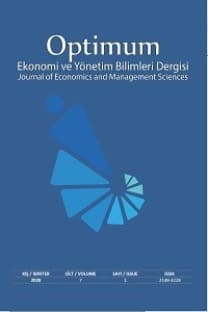İlk Evlilik Süresini Etkileyen Faktörlerin Yaşam Analizi: Türkiye Örneği
Boşanma, Yaşam Analizi, Cox Regresyon, Oransal Risk
Survival Analysis of Factors Affecting the First Marriage Period: The Case of Turkey
Divorce, Survival Analysis, Cox Regression, Proportional Hazards,
___
- Abeysekera, W. & Sooriyarachchi, M. R. (2009). Use of Schoenfeld's Global Test to Test the Proportional Hazards Assumption in the Cox Proportional Hazards Model: An Application to a Clinical Study. Journal of National Scientific Foundation, 37(1), 41-51.
- Adebowale, S. A., Fagbamigbe, F. A., Okareh, O. T. & Lawal, O. G. (2012). Survival Analysis of Timing of First Marriage Among Women of Reproductive Age in Nigeria: Regional Differences, African Journal of Reproductive Health, 16(4), ss. 95-107.
- Amato, P. R. & Preveti, D. (2003). People’s Reasons for Divorcing: Gender, Social Class, the Life Course, and Adjustment, Journal of Family Issues, 24(5), ss. 602-626.
- ASPB (2015), Türkiye’de Evlilik Tercihleri, Aile ve Sosyal Politikalar Bakanlığı, Ankara.
- Ata, N., ve Sözer, M. T. (2007). Cox Regression Models with Nonproportional Hazards Applied to Lung Cancer Survival Data. Hacettepe Journal of Mathematics and Statistics, 36(2), 157-167.
- Balakrishnan, T. R., Rao, K. V., Lapierre-Adamcyk, E. & Krotki, K. J. (1987). A Hazard Model Analysis of the Covariates of Marriage Dissolution in Canada, Demography, 24(3), ss. 395-406.
- Battal, A. (Editör). (2008). Boşanma Sebepleri, Başbakanlık Aile ve Sosyal Araştırmalar Genel Müdürlüğü, İstanbul.
- Becker, G. S. (1981). A Treatise on the Family, Cambridge, MA: Harvard University Press.
- Berrington, A. & Diamond, I. (1999). Marital Dissolution among the 1958 British Birth Cohort: The Role of Cohabitation, Population Studies, 53(1), ss. 19-38.
- Booth, A. & Edwards, J. N. (1985). Age at Marriage and Marital Instability, Journal of Marriage and Family, 47(1), ss. 67-75.
- Bumpass, L. L. & Sweet, J. A. (1972). Differentails in Marital Instability: 1970, American Sociological Review, 37(6), ss. 754-766.
- Cox, D. R. (1972). Regression Models and Life-Tables. Journal of the Royal Statistical Society-Series B (Methodological), 34(2), 187-220.
- Desrosiers, H. & Le Boundais, C. (1991). The Impact Of Age At Marriage and Timing Of First Birth On Marriage Dissolution in Canada, Canadian Studies in Population, 18(1), ss. 29-51.
- Eryavuz, A. K., & Birecikli, Ş. Ü. (2018). Türkiye'de Kadının Boşanması: Yaşam Analizi Modelleri. Çalışma ve Toplum, 3, 1227-1251.
- Harkönen, J. & Dronkers, J. (2006). Stability and Change in the Educational Gradient of Divorce. A Comparison of Seventeen Countries, European Sociological Review, 22(5), ss. 501-517.
- Karasoy, D. ve Sezayi, S. (2014). Yaşam Çözümlemesinde Hızlandırılmış Başarısızlık Süresi Modelleri ve Bir Uygulama, Süleyman Demirel Üniversitesi Fen Bilimleri Enstitüsü Dergisi, 18(1), ss.1-7.
- Klein, J. P. & Moeschberger, M. L. (1998). Survival Analysis: Techiques for Censored and Truncated Data. New York: Springer.
- Kleinbaum, D. G. & Klein, M. (2012). Survival Analysis: A Self-Learning Text (3rd Edition b.). USA: Springer.
- Lehrer, E. L. (1988). Determinants of Marital Instability: A Cox-Regression Model, Applied Economics, 20, ss. 195-210.
- Levinger, G. (1965). Marital Cohesiveness and Dissolution: An Integrative Review, Journal of Marriage and Family, 27(1), ss. 19-28.
- Murphy, M. J. (1985). Demographic and Social-economic Influence on Recent British Marital Breakdown Patterns, Population Studies, 39(3), ss. 411-460.
- Sanizah, A., Hasfariza, F., Rahayu, S. N. & Naslina, A. N. N. (2014). Determinants of Marital Dissolution: A Survival Analysis Approach, International Journal of Economics and Statistics, 2, ss. 348-354.
- Thornton, A. (1985). Changing Attitudes towards Separation and Divorce: Causes and Consequences, American Journal of Sociology, 90(4), ss. 856-872.
- Turğut, M. (Editör). (1996). Halkın Boşanmaya İlişkin Tutumları Araştırması, T.C. Aile ve Sosyal Politikalar Bakanlığı, Ankara.
- Turğut, M. (2006). Türkiye Aile Yapısı Araştırması TAYA 2006, Aile ve Sosyal Politikalar Bakanlığı, Ankara.
- Turğut, M. (2011). Türkiye Aile Yapısı Araştırması TAYA 2011, Aile ve Sosyal Politikalar Bakanlığı, Ankara.
- Turğut, M. (Editör). (2014). Türkiye Boşanma Nedenleri Araştırması TBNA 2014, T.C. Aile ve Sosyal Politikalar Bakanlığı, Ankara.
- Yay, M., Çoker, E. ve Uysal, Ö. (2007). Yaşam Analizinde Cox Regresyon Modeli ve Artıkların İncelenmesi. Cerrahpaşa Tıp Dergisi, 38, 139-145.
- Yayın Aralığı: Yılda 2 Sayı
- Başlangıç: 2014
- Yayıncı: -
Seçilmiş İslam Ülkeleri İçin Satın Alma Gücü Paritesinin Geçerliliği Üzerine Bir Çalışma
Vergi Denetim Algısına Sahip Vergi Mükelleflerinin Vergi Adaleti ve Vergi Affı Uygulamalarına Bakışı
Mustafa TAYTAK, Tuğba AKYÜZ DALKIRAN
Ticari Dışa Açıklığın Bölgesel İşsizlik Üzerindeki Etkisi: Türkiye Örneği
Türkiye’de Petrol Fiyatlarından Enflasyona Asimetrik ve Doğrusal Olmayan Geçişkenlik
Hisse Senedi Getirilerinin Marka Değeri Duyurularına Tepkisi
Ekonomik Kalkınmada Birleştirici Sosyal Sermaye Üzerine Bir İnceleme
İlk Evlilik Süresini Etkileyen Faktörlerin Yaşam Analizi: Türkiye Örneği
Şahika GÖKMEN, Anıl ERALP, Aliye ATAY KAYIŞ
Kuşaklar Arası Etkileşimin Marka Bağlılığı Üzerindeki Rolü: Takım Taraftarlığı Üzerine Bir Araştırma
